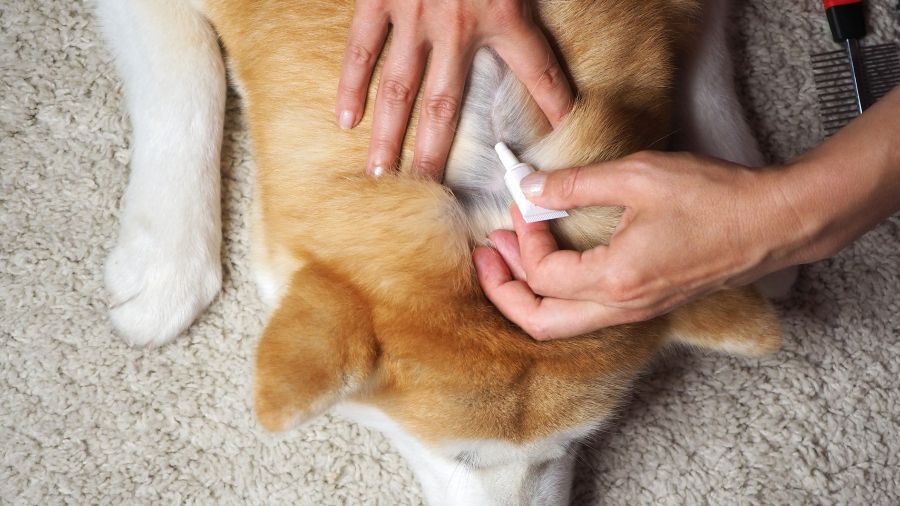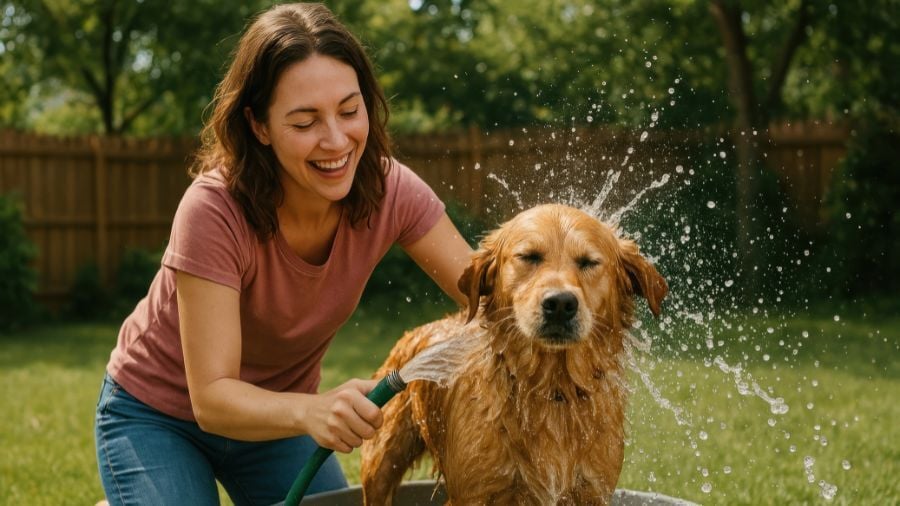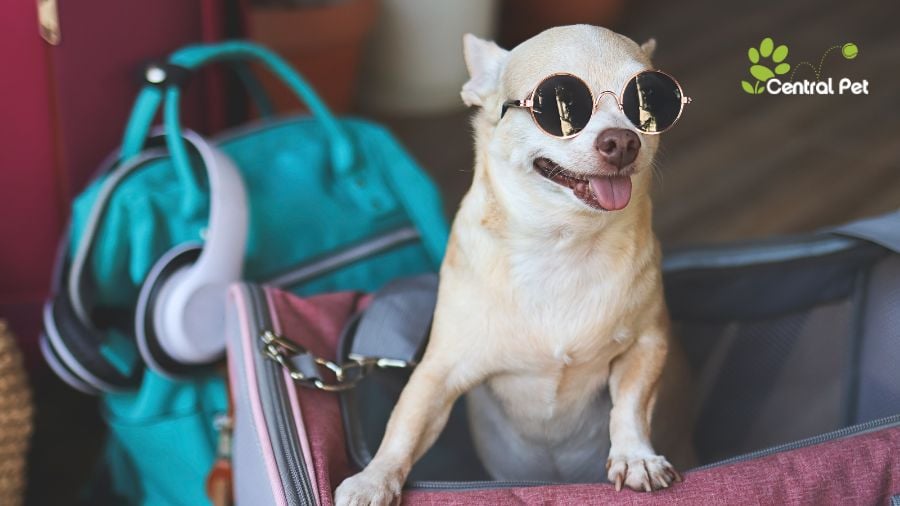Flea control is important in prioritizing your pup’s health and comfort. Not only do fleas cause itching and allergic reactions, but they can also transmit diseases and parasites. Effective flea management prevents infestations, protecting your four-legged pal and your entire home. If you’re new to the flea control conversation, knowing where to start may be a little overwhelming.
Let’s discuss the differences between prevention and treatment, the types of medications, and when it’s time to seek professional help.
Fleas and Their Impact
Fleas are small, wingless parasites that feed on the blood of animals, including dogs. Not only do they bite dogs but also other pets and even people. These pests reproduce quickly and like to live on the belly of dogs, making them easy to transfer to carpets and furniture. This can quickly lead to an infestation.
For everyone’s sake it’s best to avoid a flea infestation by regularly giving your dog flea prevention medicine.
Common Signs and Symptoms of Flea Infestation
Intense itching and scratching, particularly around the neck, tail, and groin areas, is one of the most common telltale signs that your dog likely has fleas. You might notice small, red bumps or scabs on your pup’s skin, which can become infected from excessive scratching. Flea dirt, which looks like tiny black specks, may also be visible on your dog's fur or bedding. This is essentially flea poop and digested blood.
In severe cases, dogs can develop flea allergy dermatitis (FAD), leading to hair loss, skin infections, and even anemia from blood loss, especially in young or smaller dogs.
The Best Route: Flea Prevention Medication
Talk with your vet about the right type of medication and the right timing based on:
Seasonal considerations: Fleas are more active in warmer months. If you live in southern Arizona, you may want to consider using flea prevention medication year-round because fleas are likely to be active all year.
Lifestyle and environment: Dogs that spend a lot of time outdoors, in parks, or with other animals are at higher risk and should be on continuous prevention.
Frequency of application: Most flea preventatives are given monthly. Consistency is key—set reminders to ensure timely applications. This means the fleas won’t have a chance to start reproducing on your pet and in your home.
Types of Flea Prevention Medication
Flea prevention medication includes topical treatments, oral pills, collars, and sprays designed to keep fleas away. These products work by either repelling fleas or killing them before they can infest your pet.
Topical Treatments to Help Prevent Fleas
How topical flea treatments work
Topical treatments, also known as spot-on treatments, are put directly on the dog's skin, usually between the shoulder blades. The medication spreads through the oils on the skin, killing fleas on contact.
How it’s given to your dog
- Part the fur at the application site to expose the skin.
- Apply all the contents of the tube to one spot on the skin.
- Avoid bathing your dog for 48 hours before and after application to ensure effectiveness.
Common topical flea treatment brands
- Prosense
- Frontline Plus
- Advantage II
- K9 Advantix II
You can usually purchase these without a prescription from your vet; however, it’s a good idea to talk to them about what they recommend.
Oral Medications to Prevent Fleas
How oral flea medications work
Oral flea medications are ingested by the dog and work from the inside out. Once eaten, the medication enters the bloodstream and kills fleas when they bite.
How it’s given to your dog
- Typically given once a month in a chewable format. There are some options for every 3 months.
- Dosage is based on the dog’s weight and specified by the manufacturer.
Common oral flea prevention medicines
- NexGard
- Bravecto
- Simparica
- Trifexis
These typically require a prescription from your veterinarian.
Collars for Flea Prevention
How dog flea collars work
Flea collars release active ingredients that repel or kill fleas. The active ingredients spread across the dog’s body through the natural oils on the skin and fur.
How often do you change the flea collar?
-
Most flea collars are effective for several months, ranging from 3 to 8 months.
- If your pet swims often you may need to replace it more often than the label recommends to keep the medicine active and working on the dog.
Common flea collar brands
- Seresto
- Hartz UltraGuard
- Scalibor
These can be purchased in pet supply stores and grocery stores.
Natural Remedies to Help Prevent Fleas
Natural remedies for flea prevention include essential oils (like lavender or cedarwood), apple cider vinegar, and diatomaceous earth. These methods repel fleas without the use of chemicals.
Natural remedies can be effective for mild flea prevention but often require more frequent application.
They may not be as reliable or potent as conventional medications, particularly in areas with high flea populations or for dogs with severe infestations.
How to Treat a Dog With Fleas
Flea treatment medications are products designed to eliminate fleas once an infestation occurs. In some cases, these medications can also be used after the fleas are gone to prevent another infestation.
Some products contain only an adulticide that kills adult fleas. It’s best to look for products that contain insect growth regulators (IGRs) that prevent the fleas in the larva stage from maturing. For best results in a flea infestation, use flea control products that contain an IGR. Talk to your veterinarian about the ingredients in the products you’d like to use to treat your dog.
Topical Treatments for Treating a Flea Infestation
How they work
Topical treatments, also known as spot-on treatments, contain insecticides that spread through the natural oils on your dog's skin, killing fleas on contact or when they bite.
 Application method
Application method
- Part the fur at the application site to expose the skin.
- Apply all the contents of the tube to one spot, usually between the shoulder blades.
- Avoid bathing your dog for 48 hours before and after application to ensure effectiveness.
Common brands
- Frontline Plus
- Advantage II
- K9 Advantix II
- Prosense
Many of these are also a flea prevention medicine and could be used ongoing after the fleas are no longer present on your dog.
Oral Medications for Treating a Dog With Fleas
How They Work
Oral flea medications are ingested by the dog and work systemically. The active ingredients enter the bloodstream and kill fleas when they bite.
 Dosage Information
Dosage Information
- Typically administered once a month.
- Dosage is based on the dog’s weight, as specified by the manufacturer.
Common Brands
- NexGard
- Bravecto
- Simparica
- Trifexis
As with spot treatments, oral medicines can also be used as ongoing preventive medications. However, they may take a bit longer to become effective at killing an existing flea infestation.
Shampoos and Sprays for Treating Fleas
How They Work
Shampoos and sprays kill fleas on contact. They often provide immediate relief but may require frequent application for ongoing control. When choosing a shampoo or spray, look for one that will also kill larvae.
 Application Method
Application Method
- Shampoos: Wet the dog’s coat thoroughly, apply the shampoo, lather, and let it sit for several minutes before rinsing.
- Sprays: Apply the spray evenly over the dog’s body, avoiding the face and eyes. Allow it to dry naturally.
Common Brands
- Adams Plus Flea & Tick Shampoo
- Vet's Best Flea & Tick Home Spray
- Sentry Flea & Tick Shampoo
Flea Combs and Home Treatments for Treating a Flea Infestation
Supplementary Treatments
Flea combs and home treatments can enhance the effectiveness of primary flea control methods. Flea combs physically remove fleas and their eggs from the dog’s coat. Regular vacuuming and washing of bedding help reduce flea populations in the home.
 Common Practices for Flea Combs and Home Treatments
Common Practices for Flea Combs and Home Treatments
- Use a fine-toothed flea comb daily, especially around the neck, tail, and belly.
- Wash pet bedding and vacuum floors and furniture frequently.
- Consider using flea sprays or powders for carpets and upholstery to kill fleas and their larvae in the home environment.
Combining these supplementary treatments with topical, oral, and shampoo treatments provides a comprehensive approach to managing and preventing flea infestations.
Immediate Steps When Fleas Are Discovered
- Isolate the Affected Dog: To prevent fleas from spreading to other pets.
- Begin Treatment: Apply a fast-acting flea treatment as recommended by your vet.
- Clean the Environment: Vacuum thoroughly and wash all pet bedding, toys, and fabrics in hot water.
- Monitor and Repeat: Regularly check for fleas and continue treatments as needed to ensure complete eradication.
Professional Help for Flea Control: Groomers and Veterinarians
Professional help may look different based on your dog's needs, especially if it’s becoming harder for you to keep the fleas away. When should you see a groomer, and when should you go to the vet?
When to See a Groomer When Your Pup Has Fleas
Dog groomers offer services like flea baths, which use specialized shampoos to kill fleas and soothe irritated skin. They can also provide flea combing to remove adult fleas and their eggs from the coat. Regular grooming appointments can aid in the early detection of fleas, and maintaining a healthy coat and skin may help reduce the risk of your dog getting fleas in the first place.
When to See a Veterinarian for Flea Infestation
Veterinarians can provide guidance on flea prevention and treatment tailored to your dog's specific needs. Prescription medications may be necessary for severe infestations or dogs with allergies. Additionally, you may go to a vet if your dog develops skin infections or allergic reactions due to flea bites. A veterinarian can offer treatment to relieve symptoms and prevent complications.
Dog Grooming Services in Tucson, Arizona
Preventing fleas before they become a problem saves you and your pet from the hassle and discomfort of dealing with an infestation. Regularly applying preventive medications, coupled with maintaining a clean home, ensures a happy and healthy life for your furry friend.
For expert grooming services including flea and tick dips, and additional support in flea prevention, consider Central Pet’s Grooming in Tucson, AZ. Our professional team can provide specialized treatments and guidance to keep your dog flea-free and their coat looking and feeling as healthy as possible.






